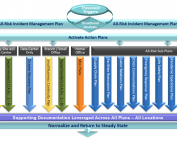The William Travis Group
Six Steps to Evolving from a BDR Provider to a Business Continuity Provider
Six Steps to Evolving from a BDR Provider to a Business Continuity Provider XaaSjournal.com December 3rd 2019 Too often, solution providers sell backups as disaster recovery, or worse yet, [...]
How to Build the Best Business Continuity Offering
How to Build the Best Business Continuity Offering XaaSjournal.com April 29th 2019 Planning, building your expertise, testing your solutions, and adapting them to change are vital to effective business continuity. [...]
5 Things to Remember When You’re Selling Business Continuity Solutions
5 Things to Remember When You’re Selling Business Continuity Solutions XaaSjournal.com December 3rd 2019 Learn all you can about your prospect and their needs, take a consultative approach, and [...]
Keeping Pace with the Evolution of New Technologies
There are four aspects to WTG that, in our view, differentiate us and the continuity solutions we construct for our clients. First, WTG profiles our client’s continuity requirements [...]
Real-time Demands for 24/7/365 Continuous Availability
Disaster Recovery/Business Continuity has changed dramatically in the last 18 to 24 months as new technologies have become available in response to real-time demands on internal processes and systems--demands [...]
State of the Industry
Global business practices, multi-site shared processing, e-commerce, new storage architectures and specialized distributed operations are forcing new requirements for much higher levels of system availability, recoverability and continuous operating [...]
The BIA’s Fatal Flaws – No. 10 A Static Report
The final flaw may be the most critical. A BIA typically is a static report whose data reflects the business’ needs at a specific point in time. Once the report [...]
WTG’s Specialty
WTG offers a unique focus on multi-tiered, multipurpose recovery architectures and on establishing disaster recovery capabilities as an inherent part of continuous business operations. We believe that it is [...]
The BIA’s Fatal Flaws – No. 9 The Devil is in the Details
The DR/BC industry is on a constant crusade to Simplify! The traditional BIA is never far behind. Unfortunately, the crusade is founded on a false belief…that DR/BC planning can be [...]
More Tough Questions…
Are the basic assumptions of your recovery plan still valid for 2018 and beyond? Can you really restore all backup data in the time allowed by your recovery time objective? [...]
The BIA’s Fatal Flaws – No. 8 RTO is a Dinosaur
Who would have thought when the terms RTO (Recovery Time Objective) and RPO (Recovery Point Objective) were coined, that 30+ years later, the industry as a whole would still be [...]
Top 25 Business Continuity Solution Providers
CIOapplications.com March 30th 2018 Having been in the industry from its inception, the William Travis Group (WTG) has seen and worked hands-on with all of the industry’s disaster recovery and [...]
The BIA’s Fatal Flaws – No. 7 The Business Will Make Up the Difference
The next problem comes from a fundamental flaw in thinking that the BIA process perpetuates. By focusing on business processes in an attempt to place responsibility for defining criticality and [...]
Ask the Hard Questions…
The Short List ; ) How does your plan help you dynamically define the recovery steps for the specific disaster event? How does your plan incorporate remote resources and [...]
The BIA’s Fatal Flaws – No. 6 The Wrong Solution Curve
This flaw manifests in sub-optimal and/or overly expensive recovery architectures. Most BIAs gather information based on the “Sweet Spot” premise. The “Sweet Spot” premise was formulated in the DR/BC industry’s [...]
How Does Your Plan Stack-up?
Curious about how your DR/BC Plan compares to similar business? Ask yourself some of the hard questions... How does your plan help you decide if and when to declare [...]
The BIA’s Fatal Flaws – No. 5 Criticality is Not Aggregated
The next flaw is a variation of the previous flaw. BIAs do not aggregate process criticality across various interdependencies. That is, they do not provide a methodology to dynamically adjust [...]
WTG’s Unique Plans
The best plans direct not only the Who, What, When and Where of the response, but also the How, Why and Why Not across all plans, all teams and [...]



















